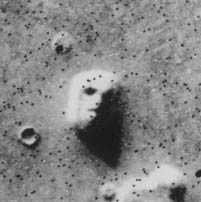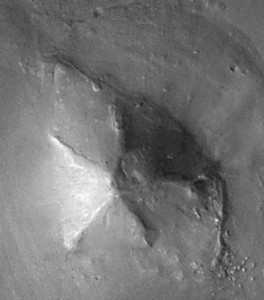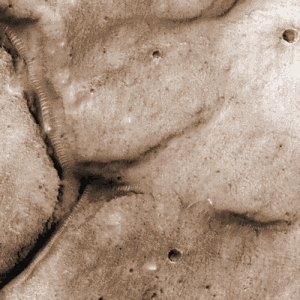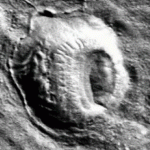The Martians’ Horrific Geometry
“He talked of his dreams in a strangely poetic fashion; making me see with terrible vividness the damp Cyclopean city of slimy green stone—whose geometry, he oddly said, was all wrong…” H.P. Lovecraft, “The Call of Cthulhu”
A surprising number of features on Mars show qualities at least somewhat suggestive of having been sculpted not by wind, dust, and water, but by hand. The best known of these features is the famous “face,” gazing up from a symmetrical plateau in the Cydonia Mensae region in the planet’s northern hemisphere. Pictures of the face and other anomalous Martian features are objects of intense interest and analysis by a large Internet community united in the search for evidence of an ancient civilization on the Red Planet, and they are objects of intense disinterest by the Jet Propulsion Laboratory, the NASA contractor that sends the orbiters that take the pictures.
 There are no smoking guns, for sure, but there are enough oddities that it is at least worth keeping an open mind to the possibility of ancient intelligent habitation of Mars, back when the planet was watery. Both those in favor and those opposed seem to agree at least on the terms of the debate—on the need to accurately interpret orbital imagery (angles of view and of illumination, understanding of imaging and data compression artifacts, etc.). Arguments for and against many of the features, for instance those of Cydonia, are made on the basis of a small set of qualities (or lack thereof) that we tend to regard as distinctive, or potentially distinctive, of artificiality: qualities like angularity, regularity, symmetry.
There are no smoking guns, for sure, but there are enough oddities that it is at least worth keeping an open mind to the possibility of ancient intelligent habitation of Mars, back when the planet was watery. Both those in favor and those opposed seem to agree at least on the terms of the debate—on the need to accurately interpret orbital imagery (angles of view and of illumination, understanding of imaging and data compression artifacts, etc.). Arguments for and against many of the features, for instance those of Cydonia, are made on the basis of a small set of qualities (or lack thereof) that we tend to regard as distinctive, or potentially distinctive, of artificiality: qualities like angularity, regularity, symmetry.
 By these standards, numerous features in the vicinity of the face are kind of artificial looking—among them an apparent “complex” of suspicious five-sided pyramids and various straight walls that look distinctly like earthworks. The face also appears to possess the telltale geometry of manufacture: It is nearly bilaterally symmetrical, it is detailed (in more recent images the right “eye socket” has been shown to have an anatomically correct eyeball-like feature), and it rises straight up from an also-symmetrical plateau that bears striking resemblance to similar ancient artificial structures on Earth. Its deviations from symmetry are small enough that they could easily be the product of long weathering and erosion. (To explore this stuff, visit Mac Tonnies’ vast Web site, The Cydonian Imperative.)
By these standards, numerous features in the vicinity of the face are kind of artificial looking—among them an apparent “complex” of suspicious five-sided pyramids and various straight walls that look distinctly like earthworks. The face also appears to possess the telltale geometry of manufacture: It is nearly bilaterally symmetrical, it is detailed (in more recent images the right “eye socket” has been shown to have an anatomically correct eyeball-like feature), and it rises straight up from an also-symmetrical plateau that bears striking resemblance to similar ancient artificial structures on Earth. Its deviations from symmetry are small enough that they could easily be the product of long weathering and erosion. (To explore this stuff, visit Mac Tonnies’ vast Web site, The Cydonian Imperative.)
I can’t help but wonder, though: To what extent is the search for extraterrestrial civilizations on Mars, or anywhere, biased by presumptions that ETs will, like us, prefer things like straight lines, symmetry, regularity? To what extent are we biased to see Euclidean forms (which do also occur in nature) as signs of intelligence, and to what extent might we fail to see intelligent design in objects and structures that have an organic, “natural” appearance?
Such a bias would be understandable given that, at least on our planet, Euclidean geometry was born hand in hand with civilization. All the things we associate with civilization arose from the imperative to more efficiently structure human ecology in conditions of dwindling resources and dwindling space—from getting more calories from a given unit of land (think of linear rows of tightly packed cornstalks vs. the wide, haphazard distribution of wild animals and plants that fed paleolithic nomads) to just plain fitting more people into more tightly packed settlements. Rectangular dwellings supplanted the circular, ovular, or irregular dwellings of Paleolithic peoples because you can fit rectangles together more tightly. The clay and stone cities of the world’s first civilizations are organized in squares and rectangles. You could say civilization’s “footprint” is the rectangle.
In other words, exerting our dominion over the plants and animals meant imposing on nature’s fractal geometry a grid instead. All our inventions, from horse-drawn carts to cars to books to silicon chips, reflect the fact that energy, matter, and information seem to be most efficiently structured through the use of straight lines and right angles, producing symmetrical forms. This rejection of nature’s fractal geometry launched us on the path to trade, mathematics, writing, science, and technology.
So on one hand, it might be reasonable to suppose that civilizations arising elsewhere will have done so out of the same imperatives, and thus will have developed a similar taste for the Euclidean. Yet it is certain that our technology, and thus our lifestyles, will ultimately depart from the Euclidean and return to the fractal, and this departure will happen sooner than we may anticipate. Space allows you to sprawl again, for one thing; and the shape of things to come, so to speak, is technology that is grown rather than manufactured. Machines will be organic and self-replicating, humans will be biomechanical. The distinction between natural and artificial may ultimately vanish altogether—or at least will appear so when viewed from afar. We are close to this threshold, and it is probable that any alien civilization we come across will have already crossed it.
Thus when trying to imagine the built environments of alien civilizations I find something somehow more realistic about the organic biomechanical worlds envisioned by artists like H.R. Giger. Giger’s “biomechanoid” environments merge machine and nature, creating a world that has transcended the Euclidean, where technology resembles bones, intestines, and genitals more than it resembles machines with moving parts, and where the living and nonliving seem to enjoy almost a parasitical or even sexual interrelationship. It’s a vision that lends itself to horror: It’s no accident Giger was inspired by H.P. Lovecraft, who described ancient gods slumbering in slimy non-Euclidean cities. Giger’s horrific images in turn inspired Ridley Scott when envisioning his sci-fi masterpiece Alien.
I think it’s because I find Giger’s vision so realistic as well as so beautiful that I’m less startled or moved by the boringly geometrical, symmetrical, Euclidean pyramids and face of Cydonia than I am by the photo below. Since this image was noticed and published by anomalist Richard Hoagland in 2000, features looking like gigantic ribbed, glassy “tubes” have been found various places on Mars, including Cydonia, and have provoked much speculation in the Mars anomaly community. Arthur C. Clarke even weighed in on this image, saying “It’s one of the most incredible images that’s ever come from space.”
 At the time, Clarke was flabbergasted that no official explanation of the feature had been offered. Ultimately the Jet Propulsion Laboratory said that these “tubes” were actually concave rather than convex features—wave-like rippling of dust at the bottom of ravines. (It is notoriously hard to tell whether surface features are “innies” or “outies” when photographed from space.) Most of them are very difficult to see as concave, however, and anomalists have interpreted them as anything from remnants of glass water pipelines or subway systems to gigantic living forms themselves, akin to Frank Herbert’s sandworms.
At the time, Clarke was flabbergasted that no official explanation of the feature had been offered. Ultimately the Jet Propulsion Laboratory said that these “tubes” were actually concave rather than convex features—wave-like rippling of dust at the bottom of ravines. (It is notoriously hard to tell whether surface features are “innies” or “outies” when photographed from space.) Most of them are very difficult to see as concave, however, and anomalists have interpreted them as anything from remnants of glass water pipelines or subway systems to gigantic living forms themselves, akin to Frank Herbert’s sandworms.
 The tubes definitely call to my mind something out of the world of Giger: Relics of an ancient, labyrinthine, biomechanoid construct—perhaps an organic habitat for a dying underground race, or perhaps a singular rhizome-like being unto itself, enjoying an almost lascivious relationship to its planet. (Mac Tonnies drew a similar analogy to Giger regarding a very organic-looking, even lewd “orifice”-like feature seen in another satellite photo—right.)
The tubes definitely call to my mind something out of the world of Giger: Relics of an ancient, labyrinthine, biomechanoid construct—perhaps an organic habitat for a dying underground race, or perhaps a singular rhizome-like being unto itself, enjoying an almost lascivious relationship to its planet. (Mac Tonnies drew a similar analogy to Giger regarding a very organic-looking, even lewd “orifice”-like feature seen in another satellite photo—right.)
Whatever the tubes are, they ain’t regular. It is ironic that Clarke, whose own iconic interplanetary artifact is the most rectilinear, unmistakeably “artificial” object possible—the lunar slab in 2001—would wax thunderstruck not at the face or any of the many suspiciously geometric objects (including apparent “monoliths”) that have been photographed on Mars, on the Moon, and elsewhere in space, but at a feature that bears far more resemblance to something from the homeworld of Alien’s fossilized star pilot.
I don’t know what the tubes really are—maybe they are natural, and maybe they are an optical trick—but I’m still with Clarke. Of all the cool and weird space pictures I’ve seen, it’s the “worms” that fill me with the most awe, the most intense curiosity, and even the most apprehension. I want to know—yet am almost afraid to know—what beings may have dwelled under the surface of Mars in, as Lovecraft might have put it, the ages before there were men.



